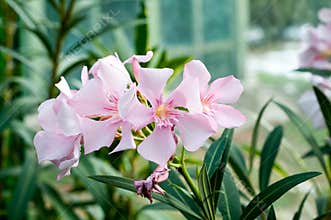Nerium Oleander. White Flowers From Bush Of Faux Laurel. Blue Skies. Nerium Oleander Grows To 2€“6 Metres Tall. It Is Most Commonly Grown In Its Natural Shrub Form, But Can Be Trained Into A Small Tree With A Single Trunk. It Is Tolerant To Both Drought And Inundation, But Not To Prolonged Frost. White, Pink Or Red Five-Lobed Flowers Grow In Clusters Year-Round, Peaking During The Summer. The Fruit Is A Long Narrow Pair Of Follicles, Which Splits Open At Maturity To Release Numerous Downy Seeds. Nerium Contains Several Toxic Compounds, And It Has Historically Been Considered A Poisonous Plant. However, Its Bitterness Renders It Unpalatable To Humans And Most Animals, So Poisoning Cases Are Rare And The General Risk For Human Mortality Is Low. Ingestion Of Larger Amounts May Cause Nausea, Vomiting, Excess Salivation, Abdominal Pain, Bloody Diarrhea And Irregular Heart Rhythm. Prolonged Contact With Sap May Cause Skin Irritation, Eye Inflammation And Dermatitis.
ID 961374960625 © Joliephantasm | Megapixl.com
Sharing is not just caring, it's also about giving credit - add this image to your page and give credit to the talented photographer who captured it.:
KEYWORDS
abdominal animals bitterness bloody blue clusters dermatitis diarrhea downy drought eye five flowers follicles frost fruit grow grows heart human humans inflammation ingestion inundation lobed mortality natural nerium pain pink plant poisoning poisonous red renders rhythm round salivation sap shrub skin sky splits toxic tree trunk white










































